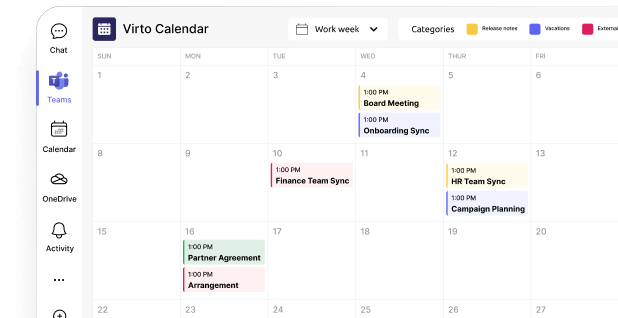Microsoft Teams Channels: How to Create and Use Them Effectively
As organizations continue to embrace hybrid and remote work models, Microsoft Teams has become an indispensable tool for maintaining productivity and team cohesion.
At the heart of Microsoft Teams’ organizational structure lies its channels feature—a powerful system for streamlining communication and workflow management. Channels serve as dedicated spaces within teams where members can focus on specific projects, topics, or departments, effectively breaking down broader collaboration into manageable, purpose-driven segments.
This comprehensive guide will walk you through everything you need to know about Teams channels, from their fundamental features and benefits to advanced usage strategies. We’ll explore different channel types, best practices for channel management, and how to leverage third-party integrations like Virto Calendar and Virto Kanban Board to enhance your team’s productivity.
What Is a Channel in Microsoft Teams?
A channel in Microsoft Teams is a dedicated workspace within a team that helps organize conversations, files, and tools around specific topics, projects, or departments. Think of channels as individual sections of a team, similar to folders in a filing system, where team members can collaborate on particular subjects or workflows without cluttering the main team space.
Each channel comes with its own:
- Conversation thread
- File storage
- Meeting space
- Shared applications
- Customizable tabs for additional tools and resources
What is the difference between a team channel and a group?
To fully understand how channels work, it’s important to distinguish between a team and a channel in Microsoft Teams:
- Team: A team is a collection of people, resources, and tools brought together for a shared purpose, such as a department, project, or business unit. Think of it as the overarching container for all related channels, files, apps, and members.
- Channel: A channel is a dedicated space within a team for focused communication and collaboration around a specific topic, project, or function. There are three main types of channels:
- Standard channels: These are open to all members of the team. Anyone in the team can see and participate in the conversations and access the files within a standard channel.
- Private channels: These offer a more controlled environment within a team. Only invited team members can access private channels, making them ideal for sensitive discussions or projects requiring limited participation.
- Shared channels: These enable collaboration with individuals outside your team, while still maintaining a connection to your team’s resources. This facilitates cross-team communication and project management without requiring external users to join the entire team.
Different channel types offer varying levels of privacy and access control to cater to diverse collaboration needs. We’ll discuss channel types in more detail below.
👉 So, what is a Teams channel? A Microsoft Teams channel is a dedicated space within a team where members can collaborate on specific topics, projects, or departments. It serves as a central hub for conversations, file sharing, meetings, and app integrations, keeping work organized and accessible.
What Are the Three Types of Teams Channels?
As discussed previously, Microsoft Teams offers three types of channels to help structure communication and collaboration effectively. Each type serves a different purpose, allowing teams to manage discussions and tasks in a way that best suits their workflow.
Below are Teams channel types:
- Standard channels
- Who can access? Available to all members of the team.
- What are they used for? Standard channels are open spaces where all team members can participate in discussions, share files, and collaborate on common tasks. These channels facilitate transparent communication and teamwork within a department, project, or business unit, ensuring everyone stays informed and aligned.
- Examples:
- A “General” channel for company-wide announcements and updates.
- A “Marketing” channel where the entire marketing team discusses campaigns and shares assets.
- A “Project XYZ” channel dedicated to organizing discussions and files for a specific project.
- Private channels
- Who can access? Restricted to only invited team members within a team.
- What are they used for? Private channels are essential when discussions need to be confidential or limited to a specific group within the team. This ensures that sensitive information, such as strategic planning or budget details, is only accessible to authorized personnel, enhancing information security and privacy.
- Examples:
- A “Leadership” channel for managers to discuss internal strategies.
- A “Budget Planning” channel for finance team members handling confidential financial data.
- A “HR & Recruitment” channel for HR professionals to manage hiring processes privately.
- Shared channels
- Who can access? Allows collaboration with people outside the team, including colleagues from other Teams or external partners, while the channel remains owned and managed by a specific team within your organization.
- What are they used for? Shared channels streamline collaboration with clients, vendors, or external collaborators without adding them to the entire team. This keeps communication focused, ensures external participants only see relevant discussions and files, and simplifies project management across organizational boundaries.
- Examples:
- A “Client Feedback” channel where a marketing team collaborates directly with a client on an advertising campaign.
- A “Vendor Coordination” channel for supply chain teams to communicate with external suppliers.
- A “Cross-Department Projects” channel where multiple teams work together without joining the same official team.
Understanding these three channel types—Standard, Private, and Shared—allows teams to structure their conversations efficiently while maintaining control over access and visibility.
👉What are Microsoft Teams channels examples? Examples of Microsoft Teams channels include a “Marketing Campaigns” channel for planning and tracking promotional activities, a “Project X Development” channel for engineers collaborating on a software release, and a “Customer Support” channel for handling client inquiries and troubleshooting. Companies often create a “General Announcements” channel for company-wide updates and a “HR & Employee Resources” channel for sharing policies, benefits, and training materials. Channels can be tailored to departments, projects, or specific workflows, ensuring that communication and collaboration remain organized and efficient.
How Do I Create a Teams Channel?
Creating a channel in Microsoft Teams is straightforward, but choosing the right type and customizing its settings significantly impacts team collaboration. This section covers:
- Creating a Standard, Private, or Shared channel
- Customizing channel settings
- Viewing all channels within a team
Creating Standard, Private, or Shared team channels
To create any type of channel, follow these simple steps:
- Open Microsoft Teams and navigate to the team where you want the channel.
- Click the More options (⋯) button next to the team name.
- Select Add channel.
- Enter a Channel name and an optional Description.
- Under Choose a channel type, select the type of channel you want to create: Standard, Private, or Shared.
- Click Create.
✅ Standard channels are best for: General discussions, department-wide collaboration, and shared projects.
✅ Private channels are best for: Confidential discussions, leadership meetings, and sensitive projects.
✅ Shared channels are best for: Working with external clients, vendors, and cross-department teams.
Remember that a Shared channel lets you collaborate with people outside your team, even outside your organization, without adding them to the full team. External users will need a Microsoft account (work/school or personal) to participate. Guest access might require additional configuration by your administrator.
👉How do I get to a Teams channel? To access a Microsoft Teams channel, open the Teams app on your desktop, web browser, or mobile device. Click on “Teams” in the left-hand navigation bar, then select the team that contains the channel you want to access. Within the team, you’ll see a list of available channels—click on the desired channel name to open it. If you don’t see the channel, check if it’s hidden under “More channels” or ask a team owner for access if it’s a private channel.
How to customize MS Teams channel settings
After creating a channel, customize its settings:
- Click the More options (⋯) button next to the channel name.
- Select Manage channel.
Here, you can:
- Modify the channel name and description
- Manage the connectors that post to the channel [Important: Teams Connectors will be retired soon. For similar functionality with improved scalability and security, use the Workflows app.
- Manage permissions for members (who can post messages, etc.).
How do I get a list of all Teams channels?
To see all channel teams:
- Open Microsoft Teams and navigate to the desired team.
- You should see a list of all available channels in the team’s channel list. Hidden channels will not be immediately visible. Click the Hidden channels option at the bottom of the channel list to view and unhide them.
By following these steps, you can effectively create, customize, and manage Teams channels, ensuring structured and efficient communication and collaboration.
👉 How to use channels in Teams? To use Microsoft Teams channels, navigate to a team and select a channel to start conversations, share files, and collaborate with your team. Post messages in the Posts tab to communicate, use the Files tab to upload and manage documents, and integrate apps like Virto Calendar for scheduling. You can also host meetings directly within a channel, ensuring discussions and resources stay in one place. Organize work by creating separate channels for projects, topics, or departments to keep communication structured and efficient.
Updates to MS Teams Channels 2024-2025
Microsoft Teams has rolled out and announced several key updates focused on improving user experience, collaboration, and organization within Channels. Here’s a summary of the changes:
- Unified Interface for Chats and Channels:
- Combined view: Teams is moving towards a unified interface combining chats and channels into a single view. This aims to streamline navigation and reduce the need to switch between different sections of the app. This is currently in public preview and expected to fully roll out in March 2025 (delayed from January 2025).
- Customization options: While the unified interface encourages a combined view, users will have the flexibility to maintain separate sections for chats and channels if they prefer, allowing for personalized organization.
- Cross-device consistency: The unified interface is being implemented across desktop, iOS, and Android platforms, ensuring a consistent experience regardless of the device used.
- Improved organization and navigation:
- Favorites: Users can now “favorite” important chats and channels for quick and easy access.
- @Mentions view: A dedicated @Mentions section highlights all messages where a user has been directly tagged, making it easier to stay on top of important conversations.
- Tag Mentions filter (coming soon): A new filter in the Activity Feed will allow users to see mentions of tags they are associated with, improving visibility for team-based notifications.
- Message forwarding: Users can now forward channel messages to other channels, individual chats, or group chats using the message ellipsis menu.
- Enhanced communication features:
- Threaded conversations (Mid-2025): The highly anticipated threaded replies feature is currently in testing and is expected to be broadly available in mid-2025. This will allow users to reply directly to specific messages within a channel, improving clarity and organization in busy conversations.
- Scheduled channel messages (Mid-2025): Users will be able to schedule messages to be sent later in channels, a feature previously only available for chats.
- Security and administrative updates:
- Phishing protection: Teams is enhancing security with built-in phishing alerts. These alerts will warn users of suspected phishing attempts within Teams Chat and will be enabled by default for all users by mid-February 2025.
- Improved VDI performance: Performance enhancements are being implemented for virtual desktop infrastructure (VDI) environments, specifically Citrix, resulting in faster call setup and improved media quality.
👉 Learn more about the updates here: Streamline collaboration with the new chat and channels experience in Microsoft Teams
These updates reflect Microsoft’s ongoing efforts to make Teams a more powerful and user-friendly collaboration platform. The changes are designed to streamline workflows, improve communication, and enhance security. Organizations using Teams should prepare for these updates and encourage users to explore the new features as they become available.
Advantages and Disadvantages of Channels on Teams
Like any tool, they come with both advantages and limitations. In this section, we will explore the key benefits of using channels effectively, as well as the potential challenges teams may face.
Advantages of channels in Microsoft Teams
Let’s start with the advantages:
✅ Simplified team structure: Channels organize work by separating discussions based on project, department, or topic, preventing chaos and ensuring everyone knows where to find information.
* Example: A marketing team can have separate channels for “Campaign Planning,” “Social Media Strategy,” and “Content Creation.”
✅ Centralized communication and tasks: All project-related discussions, tasks, and documents reside in one place, reducing the need for scattered emails or external tools. Threaded replies keep conversations organized and easy to follow, preventing important messages from getting lost in long chat histories.
* Example: A development team can use a dedicated channel to track progress, share code, and discuss updates.
✅ Secured access by project or task: Private or shared channels ensure only authorized personnel access specific information, crucial for sensitive data like customer contracts or financial records.
* Example: A finance team can create a private channel for budget discussions, restricting access to sensitive financial reports.
✅ Integration with other tools: Channels integrate with built-in and third-party apps, connectors, bots, and Power Automate, creating robust workspaces. You can add tabs for Planner, OneNote, SharePoint, or tools like Virto Calendar and Virto Kanban Board.
* Example: A project manager can integrate the Virto Kanban Board and Virto Calendar for easier task management and tracking of important project milestones.
✅ Transparency and accessibility: Channels facilitate easy access to conversations, shared files, and past discussions, eliminating the need for constant updates.
* Example: New team members can quickly get up to speed by reviewing the channel’s history.
✅ Customizable channel types: Standard, Private, and Shared channels cater to diverse communication needs.
* Example: A law firm can use private channels for case discussions and shared channels for external consultant collaboration.
Disadvantages and limitations of channels in Microsoft Teams
Despite its advantages, Microsoft Teams has certain limitations:
❌ Complexity of management for large teams: Excessive channels can cause confusion. Clear channel-naming conventions, guidelines for creation, and proper team training are crucial.
* Example: A large company with numerous departments needs clear channel organization to prevent information overload.
❌ Limited customization: While customization is possible (apps, tabs, permissions), deeper structural customization is limited. However, improved search and filtering within channels, including using filters like “from:user” or “has:link,” help locate information.
* Example: While you can’t create custom discussion categories, using tags and leveraging the enhanced search features can improve organization.
❌ Limitations on moving data between channels: Moving files is relatively easy, but transferring entire conversations between channels remains cumbersome. Consider cross-posting messages to multiple channels or using SharePoint for centralized file management.
* Example: If a project moves to a new phase, manually transferring relevant information can be time-consuming.
❌ No automatic archiving: Teams lacks automatic channel archiving. Inactive channels can clutter the workspace. Team admins should manually hide or delete old channels and leverage retention policies in the Microsoft 365 Admin Center.
* Example: Outdated project channels can make it difficult to find current information.
Here’s a summary of advantages and disadvantages of Teams channels for easy reference:
| Advantages | Disadvantages |
| Organized communication: Streamlines conversations by project, topic, or department. | Management complexity (large teams): Overabundance of channels can lead to confusion if not managed carefully. |
| Centralized hub: Consolidates discussions, files, and tasks in one location. | Limited customization: While improving, some structural limitations exist (e.g., custom categories). |
| Controlled access: Private and shared channels ensure appropriate information access. | Difficult data transfer: Moving conversations between channels is cumbersome. |
| Tool integration: Seamlessly integrates with other apps and services. | No automatic archiving: Requires manual archiving of inactive channels. |
| Enhanced transparency: Easier for team members to stay informed and access past discussions. | |
| Flexible channel types: Supports various collaboration scenarios with standard, private, and shared channels. |
Microsoft Teams channels offer structured communication and task management, but require planning and governance. By using the right channel types, integrating useful apps, and establishing clear management rules, teams maximize productivity and minimize confusion. A well-defined channel lifecycle management strategy is essential for long-term success.
Examples of Using Channels in Teams
Microsoft Teams channels can be tailored to fit a variety of workplace needs, from project management to client collaboration, education, and event planning. In this section, we’ll explore real-world scenarios where channels improve organization, communication, and efficiency.
Project management
Using channels for project management allows teams to create dedicated spaces where they can:
✔ Discuss project details without cluttering the general team chat
✔ Store and share project files, documents, and reports
✔ Schedule meetings and track project milestones
Example:
A marketing team might have separate channels for:
- “Paid Advertising”: for managing Google Ads and social media campaigns
- “SEO Content”: for brainstorming blog topics and tracking keyword research
- “Product Launches”: for coordinating PR, email campaigns, and influencer outreach
✅ Best practice: Integrate tools like the Virto Kanban Board App into the project channel to track tasks visually.
Collaborating with clients
With Shared channels, teams can work directly with clients, contractors, or partners without exposing internal discussions.
✔ Maintain separate communication threads for each client
✔ Share meeting notes, project updates, and reports
✔ Keep internal team discussions private while allowing external collaboration
Example:
A consulting firm creates a dedicated channel for each major client, where they:
- Share weekly progress reports
- Schedule virtual check-ins, using the Virto Calendar App
- Store project documentation in a centralized location
✅ Best practice: Use channel permissions to ensure only relevant team members have access.
Educational institutions
Microsoft Teams is widely used in education to facilitate remote learning and collaboration between students and faculty.
✔ Create separate channels for different study groups or courses
✔ Store lecture notes, assignments, and resources
✔ Host virtual discussions and Q&A sessions
Example:
A university professor creates a “Project: Market Research” channel where students can:
- Collaborate on group assignments
- Share research materials and case studies
- Discuss findings and project milestones with their professor
✅ Best зractice: Use Microsoft OneNote integration in channels to provide a structured learning resource for students.
In-house training & knowledge sharing
Channels are a great way to organize employee training, onboarding, and professional development.
✔ Store and share training materials, guides, and recorded sessions
✔ Facilitate Q&A discussions and knowledge-sharing forums
✔ Schedule live training sessions and feedback meetings
Example:
A company creates a “Sales Training” channel where:
- New hires can access onboarding materials and product guides
- Trainers share weekly webinars and best practices
- Employees ask questions and discuss sales strategies
✅ Best practice: Use Teams Wiki or OneNote within the channel to maintain an accessible knowledge base.
Teamwork on products
For companies developing products or services, channels help teams:
✔ Coordinate product development tasks
✔ Discuss new features, customer feedback, and improvements
✔ Share technical documentation and prototypes
Example:
A software development team creates separate channels for:
- “UI/UX Design”: for wireframes and feedback discussions
- “Bug Tracking”: where testers report issues and developers address fixes
- “Feature Roadmap”: where managers prioritize upcoming releases
✅ Best practice: Integrate Planner or Trello into the channel to track product development sprints.
Event management
Event planning teams use channels to:
✔ Organize logistics, schedules, and vendor communications
✔ Share event marketing materials and guest lists
✔ Coordinate team tasks and deadlines
Example:
A corporate events team creates a “Company Annual Summit” channel where they:
- Assign tasks for venue booking, catering, and speaker coordination
- Store event agendas and promotional materials
- Share updates and last-minute changes with the team
✅ Best practice: Use the Virto Calendar App in the channel to schedule key deadlines and event milestones.
Departments and functions within a company
Larger organizations can create channels for specific departments or key business functions, ensuring streamlined communication.
✔ Keep departmental discussions organized and accessible
✔ Store and manage internal documentation
✔ Facilitate cross-team collaboration on strategic initiatives
Example:
A company creates dedicated channels for:
- “HR & Recruitment”: managing job postings, interviews, and onboarding
- “Finance & Budgeting”: handling expense reports and financial planning
- “IT Support”: where employees can report technical issues and request assistance
✅ Best practice: Assign channel moderators to manage discussions and ensure important updates are pinned for visibility.
Channel vs. Chat: When to Choose a Channel in Microsoft Teams
Microsoft Teams offers two primary ways to communicate: Channels and Chats. While both allow for collaboration, they serve different purposes. In this section, we’ll explore the limitations of using chats, the advantages of using channels, and when to choose one over the other.
Limitations of using chats
While chats are useful for quick conversations, they have several drawbacks when used for team collaboration:
❌ Limited topic organization: Chats lack structured topic organization. Conversations flow chronologically, making it difficult to track specific subjects within long threads. This can lead to confusion and critical information getting buried.
❌ Information loss for new members: New chat participants cannot access past conversation history. This creates a knowledge gap and hinders onboarding for new team members.
❌ Lack of integrated tools: Chats do not integrate with other Teams features like file storage, task management, or calendar scheduling. This limits their usefulness for collaborative projects.
❌ No app integration or tabs: Unlike channels, chats do not support adding tabs for apps like Planner, OneNote, SharePoint, or other third-party tools. This restricts the ability to centralize resources and workflows.
❌ Scattered file storage: Files shared in chats are not centrally stored, making them difficult to locate and manage effectively.
❌ Limited automation: Chats do not support process automation through tools like Power Automate, hindering workflow integration and notification management.
Advantages of using channels
Compared to chats, channels provide a more structured and efficient way to collaborate:
✅ Organized conversations: Channels allow topic-based organization, making it easy to follow different conversations within a team or project. This improves clarity and reduces information overload.
✅ Centralized resource hub: Channels provide a central location for files, meetings, tasks, and other relevant information, promoting easy access and streamlined collaboration.
✅ Persistent conversation history: All team members have access to the entire channel history, ensuring transparency and eliminating the need for repetitive updates.
✅ Enhanced app integration: Channels allow adding tabs for various apps, including Files (SharePoint, OneDrive), Calendar, Tasks (Planner, Trello, Asana), and other tools, creating a centralized workspace.
✅ Ideal for ongoing projects: Channels are designed for long-term projects and team collaboration, providing a persistent space for discussions, file sharing, and task management.
When to use channels vs. chats
Here’s when to prefer one over the other:
Use a channel when:
- Managing ongoing projects requiring structured communication, file sharing, and task management.
- Discussing team-wide tasks and initiatives.
- Creating dedicated spaces for departments or long-term projects.
- Integrating with other apps and services for streamlined workflows.
- Leveraging threaded conversations (coming mid-2025) for focused discussions within a channel.
Use a chat when:
- Sending quick, informal messages to individuals or small groups.
- Engaging in temporary discussions that don’t require persistent storage.
- Having private conversations that are not relevant to the broader team.
Key considerations with the latest updates
- Unified interface (March 2025): Be aware of the upcoming unified interface for chats and channels. While it offers a combined view, customization options will allow you to maintain separate sections if preferred.
- Threaded conversations (Mid-2025): Anticipate the arrival of threaded conversations in channels, which will significantly improve organization and focus within channel discussions.
By understanding the strengths of each communication method, you can optimize your team’s collaboration and communication within Microsoft Teams. These updates will help make using channels and chats even more effective.
Using Calendars in Microsoft Teams Channels and Choosing the Right Tool
Calendars play a crucial role in organizing team schedules, meetings, and project timelines within Microsoft Teams channels. While Microsoft Teams offers a built-in Channel Calendar, it has several limitations that can hinder productivity. In this section, we’ll explore the challenges of using a Channel Calendar, how to expand its functionality with the Virto Calendar App, and why Virto Kanban Board App can further enhance your team’s workflow.
Microsoft Teams Channel Calendar: Overview and limitations
The Channel Calendar is directly integrated into Teams, offering a simple way to schedule meetings and events visible to all channel members. However, its functionality is basic, presenting several limitations:
- Limited views: Only Day, Work Week, and Week views are available, hindering long-term planning or visualizing tasks alongside events.
- No multi-calendar overlay: Users cannot view multiple calendars simultaneously, including other Teams channels, external calendars (Google Calendar, iCal), or even personal Outlook calendars within the Channel Calendar.
- No color-coding or categorization: Events cannot be visually distinguished by project, type, or any other criteria, making it difficult to quickly grasp the schedule at a glance.
- One calendar per channel: Each channel is restricted to a single calendar, creating organizational challenges for teams managing multiple projects or event types within the same channel.
- Limited mobile experience: The Channel Calendar’s functionality is heavily reduced compared to the desktop version.
- No guest access: External users or members of other Teams channels cannot be added to or view a Channel Calendar, limiting collaboration outside the immediate channel group.
- No Shared channel support: Private or shared channels do not support Channel Calendars, restricting their use in scenarios requiring more controlled access.
- Integration gaps: Direct integration with task management tools like Microsoft Planner, Kanban boards, or third-party solutions is lacking. This makes it difficult to manage tasks and deadlines alongside scheduled events within the Teams environment.
Virto Calendar App: Significantly Improved calendar functionality
Virto Calendar is a third-party Microsoft-vetted app designed to address the limitations of the native Teams Channel Calendar. It offers a range of advanced features:
- Multi-calendar overlay: Virto Calendar allows users to view multiple calendars simultaneously, including Microsoft 365, Google Calendar, iCal, and SharePoint calendars. This provides a consolidated view of all relevant schedules.
- Diverse views: Beyond standard Day and Week views, Virto Calendar offers monthly, yearly, and task-based views (among others), enabling users to manage deadlines and projects directly within the calendar interface.
- Color-coding and customization: Events can be color-coded and categorized for improved visual organization and quick identification of different event types.
- Mobile optimization: Virto Calendar provides full functionality across both desktop and mobile Teams clients, ensuring a consistent experience regardless of the device used.
- Security and compliance: Virto Calendar adheres to Azure authorization and compliance standards, ensuring data security.
- Third-party app and licensing: Virto Calendar is not a native Teams feature and requires separate licensing.
In summary, the native Microsoft Teams Channel Calendar is suitable for basic scheduling within a channel. However, its limitations can hinder teams requiring more advanced features, cross-calendar visibility, or tighter integration with task management tools. Virto Calendar offers a robust alternative with enhanced functionality that includes multiple views, color-coding, and categorization, while adhering to Microsoft security standards.
Complementing Teams with Virto Kanban Board App
While we’ve explored Virto Calendar’s functionality, let’s briefly discuss the Virto Kanban Board app, which can also enhance Teams and channel functionality by being added as a tab. This combination creates a powerful, integrated project management system directly within the familiar Microsoft Teams environment. Here’s a breakdown of how Virto Kanban improves Teams:
- Centralized project management: Virto Kanban brings Kanban boards directly into Teams channels. This centralizes communication, task management, and progress tracking, eliminating the need for separate project management tools and reducing context switching.
- Visualized workflow: The Kanban board provides a clear visual overview of the project’s workflow. Teams can easily see the status of each task, who is assigned to it, and upcoming deadlines. This visual representation simplifies progress tracking and helps identify potential bottlenecks.
- Enhanced collaboration: By integrating with Teams, Virto Kanban fosters better collaboration. Team members can discuss tasks, share updates, and make decisions directly within the context of the Kanban board, streamlining communication and improving teamwork.
- Informative task cards: Virto Kanban’s detailed task cards provide all the essential information in one place. These cards include deadlines, assignees, progress status, and other relevant details, ensuring everyone has access to the necessary information.
- Improved planning and backlog management: The app facilitates better planning and backlog management. Teams can prioritize tasks, organize their workflow, and manage their backlog effectively, maximizing their output and ensuring projects stay on track.
- Capacity and bottleneck management: Virto Kanban helps teams assess their capacity and identify potential bottlenecks. This allows for better workload distribution and proactive adjustments to prevent roadblocks and ensure smooth project execution.
- Reporting and insights: The app offers detailed reports that provide valuable insights into project progress. This data-driven approach helps teams make informed decisions, identify areas for improvement, and adjust their strategies as needed.
- Cross-platform accessibility: Virto Kanban is accessible on MS Teams Web, Desktop, and Mobile App, providing flexibility for all users, regardless of their location or device. This ensures everyone can stay connected and contribute to the project.
- Integration with SharePoint: Virto Kanban connects with SharePoint, allowing teams to turn their SharePoint lists into agile Kanban boards. This leverages existing data and further centralizes project information.
In essence, Virto Kanban transforms Microsoft Teams from a communication platform into a comprehensive project management environment. It streamlines workflows, improves collaboration, and provides valuable insights, ultimately boosting team productivity and project success.
Conclusion on What Is a Channel in Teams
In conclusion, Microsoft Teams channels provide a powerful and versatile way to streamline teamwork and communication. They offer a structured environment for organizing conversations, sharing files, and integrating essential apps, ultimately boosting productivity.
However, the built-in calendar functionality in standard channels can sometimes be limiting. Using the Virto Calendar App can significantly enhance the standard calendar features, enabling more efficient scheduling, planning, and overall workflow management.
We encourage you to explore the different channel types—standard, private, and shared—and experiment with various integrations to find the optimal setup for your team’s needs. Don’t overlook the potential of the Virto Calendar App to elevate your team’s scheduling and planning capabilities. We encourage you to schedule a quick demo of the app or install a free trial to check its capabilities.
To further enhance your understanding and optimize your Teams experience, we recommend exploring the following resources:
Official Microsoft resources:
- Overview of Teams and Channels
- First Things to Know About Channels in Microsoft Teams
- Teams and Channels Overview
- Teams and Channels in Microsoft Teams
- Creating a Standard, Private, or Shared Channel
- First Things to Know About Teams in Microsoft Teams
- Creating a Community and Channel in Microsoft Teams
- What Are Communities and Channels in Microsoft Teams
Our blog posts:






